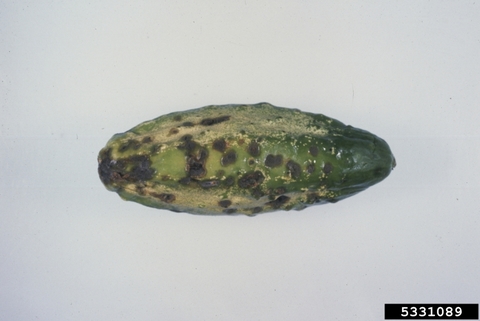Quick facts
- The fungus Cladosporium cucumerinum causes scab. The fungus infects cucumbers, melons, summer squash, pumpkins and winter squash.
- Watermelon is very resistant to the disease and many varieties of cucumber that have resistance to scab are now available.
- Leaf spots are white to gray and may have a yellow halo. As the infection ages, the center of the leaf spot falls out.
- Scab travels on infected seeds or as spores carried on moist air currents.
- Disease develops in cool (around 70°F), moist weather.
- Rotate vegetables so two or more years go by before planting any member of the squash family in the same location.
- Do not work with plants when wet.
- The extent of fruit rot varies depending on the variety’s resistance.
How to tell scab from other vining vegetable issues
Leaf spots are white to gray and may have a yellow halo.
- As the infection ages, the center of the leaf spot falls out. Leaves look ragged.
- Cucumber, summer squash, zucchini and pumpkin have sunken fruit spots covered with greenish-black, velvety fungal growth.
- Somewhat resistant winter squash have raised corky areas on infected fruit.
- The extent of fruit rot varies depending on the variety’s resistance.
Biology
- Scab travels on infected seed or as spores carried on moist air currents. Fungal spores then spread through the field by wind, insects, tools and workers.
- Scab survives the winter in plant debris and, once introduced, can reoccur season after season if not treated correctly.
- Disease develops in cool (around 70° F), moist weather.
- Summer squash, pumpkins and cucumbers (varieties not specifically bred for disease resistance) are very susceptible to the disease.
- Fruit infections on these crops will produce spores and rot will extend deep into the fruit.
- Gourds and some winter squash (blue hubbard, buttercup) are moderately susceptible and will show symptoms on both leaves and fruit. Fruit infections will not extend deep into the fruit.
- Moderately resistant squash, like acorn and butternut, have few leaf spots and fruit infections will be raised, tan, corky spots instead of sunken craters. Fruit spots in these crops rarely produce fungal spores.
- Fruit with only a few, shallow scabs can be eaten by cutting around the damaged areas and cooking the fruit. More severe infections can lead to rot and fruit should be disposed of.
Cucumber with black scab lesions
Managing scab in home gardens
Correct identification of garden issues
- Scab disease is uncommon in Minnesota, but there are many things that can cause scabs in vining vegetables.
- Feeding by insects and rodents can cause scabby areas on fruit.
- A physiological issue referred to as oedema can happen if fruit get too much water.
Cultural controls
- Purchase clean seed from a reputable source. Do not save seed from infected plants.
- Rotate vegetables so two or more years pass before planting any member of the squash family in the same location.
- Use drip irrigation instead of overhead sprinklers if possible. If you’re watering by hand, water at the base of the stem.
- Do not work in plants when they are wet.
- Remove and destroy infected fruit and vines at the end of the season in small gardens.
Managing scab on farms
|
- Purchase clean seed from a reputable source. Do not save seed from infected plants.
- Rotate vegetables so two or more years go by before planting any member of the squash family in the same location.
- Use drip irrigation instead of overhead sprinklers if possible.
- Do not work in plants when they are wet.
- Remove and destroy infected fruit and vines at the end of the season in small plots.
- In large fields, till under crop residue at the end of the season to speed up decomposition.
- In no-till fields, use a flail mower to chop residues into small pieces so that they break down faster.
- Resistant varieties of cucumber are available and are the best management option for that crop.
- Preventative sprays are effective but are only necessary in fields with a history of scab.
- Squash sprays should start at bloom.
- Melon and pumpkin sprays should start when the vines begin to run.
Several fungicides are available for use against scab. Commercial growers should refer to the Midwest Vegetable Production Guide for specific fungicide recommendations.
CAUTION: Mention of a pesticide or use of a pesticide label is for educational purposes only. Always follow the pesticide label directions attached to the pesticide container you are using. Be sure that the plant you wish to treat is listed on the label of the pesticide you intend to use. And observe the number of days between pesticide application and when you can harvest your crop. Remember, the label is the law.
Reviewed in 2022




